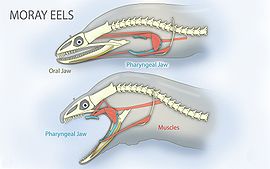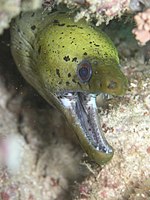|
Moray eel
Moray eels are large cosmopolitan eels of the family Muraenidae. There are approximately 200 species in 15 genera. The typical length of a moray is 1.5 m (5 ft), with the largest being the slender giant moray, Strophidon sathete, at up to 4 m (13 ft).
[edit] Anatomy


Muraena Helena showing typical moray eel morphology: robust anguilliform shape, lack of pectoral fins and circular gill openings.
The dorsal fin of the moray extends from just behind the head, along the back and joins seamlessly with the caudal and anal fins. Most species lack pectoral and pelvic fins, adding to their snake-like appearance. Their eyes are rather small; morays rely on their highly developed sense of smell, lying in wait to ambush prey.
The body of the moray is patterned, camouflage also being present inside the mouth. Their jaws are wide, with a snout that protrudes forward. They possess large teeth, designed to tear flesh as opposed to holding or chewing.


Moray eel jaw anatomy
Moray eels' heads are too narrow to create the negative pressure that most fish use to swallow prey. Moray eels have a second set of jaws in their throat called pharyngeal jaws, which also possess teeth. When feeding, morays launch these jaws into the oral cavity, where they grasp struggling prey and transport it into the throat and down to the rest of the digestive system. Moray eels are the only known type of animal that uses pharyngeal jaws to actively capture and restrain prey.[1][2][3] Morays are capable of inflicting serious wounds to humans.
Morays secrete a protective mucus over their smooth scaleless skin which contains a toxin in some species. Morays have much thicker skin and high densities of goblet cells in the epidermis that allows mucus to be produced at a higher rate than in other eel species. This allows sand granules to adhere to the sides of their burrows in sand-dwelling morays[4], thus making the walls of the burrow more permanent due to the glycosylation of mucins in mucus. Their small circular gills, located on the flanks far posterior to the mouth, require the moray to maintain a gape in order to facilitate respiration.
Morays are carnivorous and feed primarily on other fish, cephalopods, mollusks, and crustaceans. Groupers, other morays, and barracudas are among their few predators. There is a commercial fishery for several species, but some have been known to cause ciguatera fish poisoning. Morays hide in crevices in the reefs, and wait until their prey is close enough for capture. They then lunge out and clamp the prey in their strong jaws.
[ Behavior
[Cooperative hunting


Ribbon moray,
Rhinomuraena quaesita
In the December 2006 issue of the journal Public Library of Science Biology, a team of biologists announced the discovery of interspecies cooperative hunting involving morays. The biologists, who were engaged in a study of Red Sea cleaner fish (fish that enter the mouths of other fish to rid them of parasites), discovered that a species of reef-associated grouper, the roving coral grouper (Plectropomus pessuliferus), often recruited morays to aid them while hunting for food. This is the first discovery of cooperation between fish in general. [5] [6]


Fimbriated moray,
Gymnothorax fimbriatus
Reputation
Morays have sometimes been described as vicious or ill-tempered. In fact, morays are shy and secretive, and they only attack humans in self-defense. They also accidentally bite human fingers when being fed, because they cannot see or hear very well, although they have an acute sense of smell. Morays hide from humans and would rather flee than fight. Morays, however, do inflict a nasty bite, because, although not poisonous, their backward-pointing teeth are covered with bacteria which may infect the wound. Another danger that morays present is when they are eaten. If the eels have eaten algae, or fish that have eaten algae, they will cause ciguatera fish poisoning if eaten. Morays rest in crevices during the day and are nocturnal predators, and although they may ensnare small fish and crustaceans that pass near them during the day, they mostly come out at night. [7]
[Distribution
Moray eels are cosmopolitan, found in tropical and temperate seas.
[ Habitat
Morays usually live in warm waters, and subtropical coral reefs to depths of 150 m, where they spend most of their time concealed inside crevices and alcoves.
South Florida and Miami fishing available at an affordable price. |











